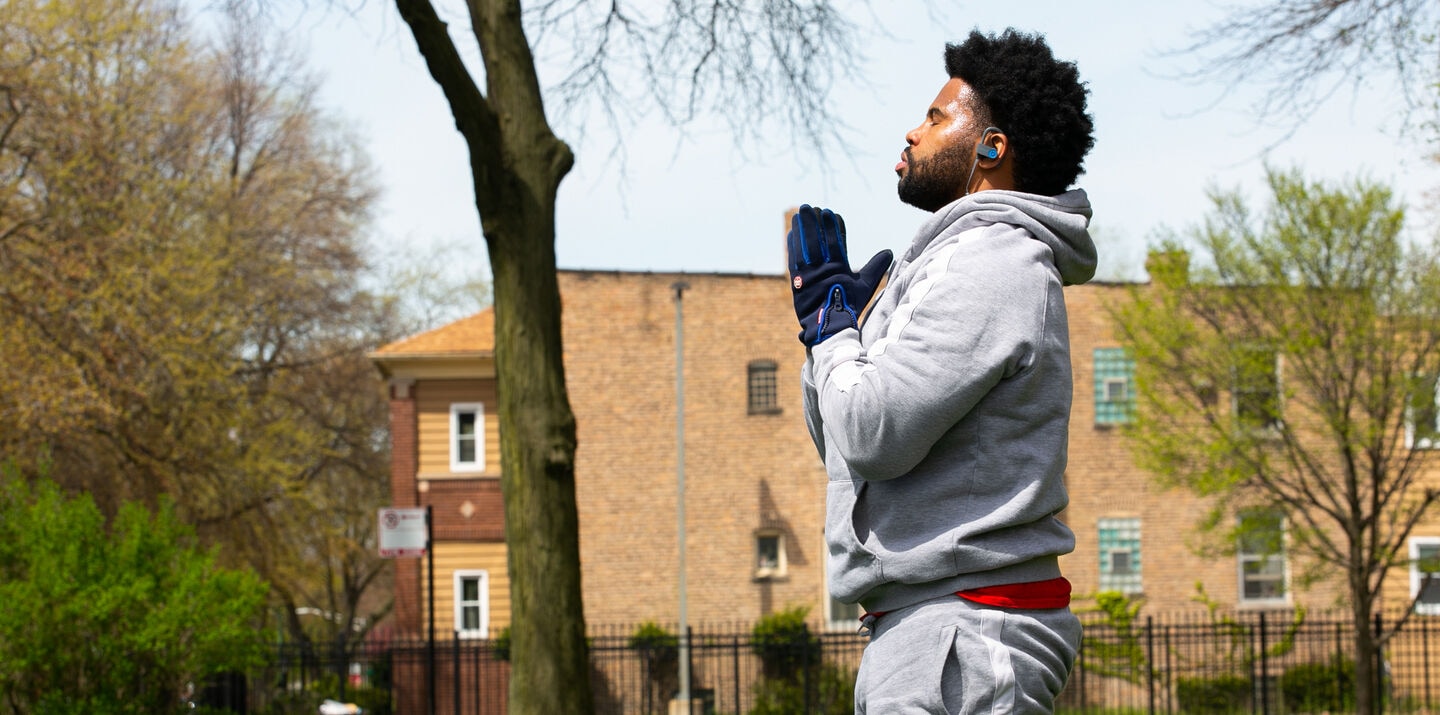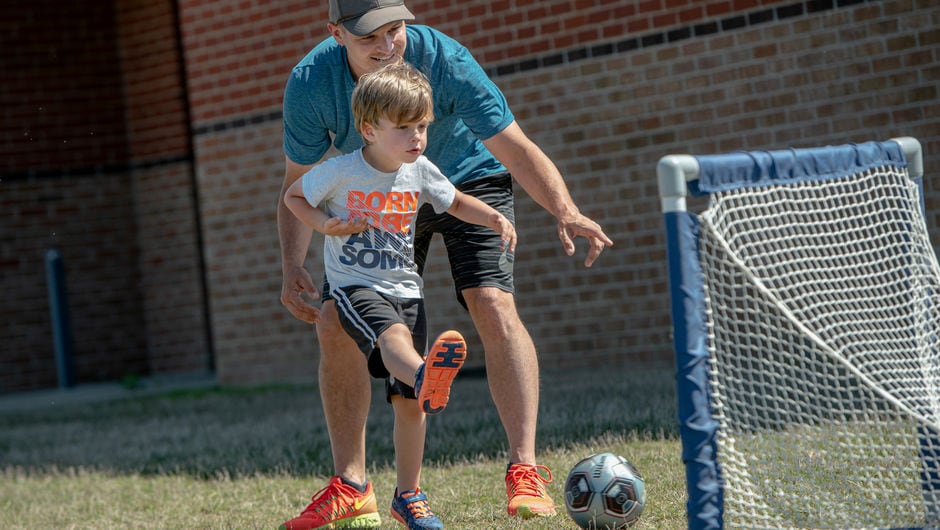
These PE Teachers Aren’t Keeping Score
Think less tag, more yoga, less scorekeeping, more joy when these teachers take the lead on students’ holistic health.
Image above: “If you can feel that you control each muscle in your body because it’s yours, that's physical education,” says Brandon Carr, practicing mindfulness techniques near his Chicago home. Photo by Kristan Lieb
Healthy, confident kids tend to grow into healthy, confident adults. And doesn’t that sound wonderful right now? But to get there, kids need thoughtful physical education focused on holistic well-being, say teachers Brandon Carr (Jacksonville ’14) and Jason Reid (Greater Delta ’09). Glorified recess, it is not.
Carr, a candidate for National Board Certification, plans to resume teaching in the fall at Charles Sumner Math & Science Community Academy, a pre-K-8 school on Chicago’s West Side. Physical education, he says, provides him the chance to build relationships with students where he can be real with his full range of emotions and model how to process feelings in healthy, productive ways.
Reid, who taught for seven years in rural Mississippi, plans to return to teaching grades 3-5 at Horn Lake Intermediate School in a Mississippi suburb of Memphis, Tennessee. As a former Division I college football player and a cancer survivor, Reid’s focus is on teaching his students the skills they need to cooperate and thrive. “This is about the health and wellness of our nation,” he says. “Physically, emotionally, we want people to grow up and be able to take care of themselves and each other.”
These physical education fanatics connected over the phone for an energetic conversation about their discipline (condensed and edited for clarity). They discussed everything from junk food to social-emotional wellness—and why true physical education is the subject kids might need now more than ever.

JASON: Hey Brandon, good to meet you. I’m excited to have this conversation.
BRANDON: Likewise! Honored to have the chance to talk about being physical educators. A big part of my work when I started at my current school was getting teachers and staff to understand that it’s not “gym” class—to get them to put an actual name on the class. It’s physical education. You can’t expect to do recess stuff. You are coming here to be educated.
JASON: Right, exactly. So I want to hear your take on the question of physical education in a perfect world. What would a school system look like to really support us? I’m curious what you think of that.
BRANDON: In a perfect world here in Chicago, every school would have an enclosed indoor and outdoor facility to accommodate different types of activities and sports and games in all types of weather. Facilities are a safety issue. At our school, if I take the students outside, people from the neighborhood can just walk up to them—there’s no privacy for learning to happen. And so much can happen outside of the school walls, so it puts me at a disadvantage when it comes to me trying to expose students to different things outside. How can we really get physical if we're trapped inside?
JASON: When I think about what the research says about movement as it relates to learning, I think in a perfect world we’d have PE every day. Recommendations are for kids to get at least 60 minutes per day of activity, and that’s far short of what we’re able to provide them with PE only about once a week.
I also think about nutrition. We’re a Title I school in Mississippi, which ranks near the top in terms of rates of obesity, diabetes, and cardiovascular disease. Occasionally they have me on lunch duty and I'm looking at the food and I'm thinking, “Why are we serving some of this stuff?” In a perfect world, we would have really nutritious, nutrient-dense, healthy food that we’re serving for breakfast and lunch.
BRANDON: I can connect with that. I've become like a nutritional bully because I'm always trying to eat healthy foods. So when I see kids eating chips, I'm like, “Yo, let's read the back of that and see what you're putting in your body!”
JASON: In our classroom, we have a good sportsmanship code that we read every day like it’s the Pledge of Allegiance. It’s about teamwork, cooperation, and giving 100% effort. I really want to teach kids perspective in life. I want them to know that in PE and in life, a lot of times you’re going to try your best but you’re not going to succeed, or someone else will do better. But that doesn’t mean you didn’t do well, and it doesn’t mean you’re not growing. It doesn’t mean you’re not getting better. It means that you can keep at it.
BRANDON: When I first started working at my school, the kids were really competitive. So we spent a lot of time in my first two years breaking down what it means to be a teammate and a good sport. Now I’m on a journey of bringing yoga to the classroom to help them understand self-control and how the choices they make can affect their lives. At the start of every week, each class has one PE period dedicated to yoga and meditation—getting them into the idea of controlling their body and understanding that things start with a breath.
That plays into their competitiveness, because now when they're about to go off the hinge, I’m able to bring them back to the yoga practice. Breathe. Think about what’s going on. Express your feelings. This gets them to understand that it's OK to feel a certain way and then process that emotion in a way that is conducive to themselves and the class and community. And it forces me to do the same thing, to effectively model what it looks like to run through my emotions out loud. A lot of it is getting them to think before they act. That's my goal.
JASON: I can make a lot of connections with the stuff you're talking about. You know, I was thinking about the ways that kids show growth in the PE classroom. And it isn’t so much in physical activity. It’s the social-emotional wellness—exhibiting self-control in situations that they previously never were able to. We’ve got that traditional growth—kids who weren’t good at activities, or didn’t enjoy them, then learning to find their place and improve. But the bigger successes, like you said, are the kids who learn to control their emotions. It’s not the physical stuff; it’s the emotional stuff.
As a student, I don’t remember being impacted by No Child Left Behind. But when I became a teacher in 2009, it was all focused on the state testing. It’s so important to schools, but PE has been relegated to the side, and with it a lot of the social-emotional wellness that goes with it. We're one of the last places teaching things like controlling your breathing, controlling your body—not so that you can catch and throw, but so you can make choices that will lead you to success and opportunities.
BRANDON: In some ways, I feel like No Child Left Behind has sent a message to some kids that there are no repercussions for quitting, because schools feel pressured to pass them along anyway. So I feel like part of my work is getting students to understand that it’s not OK to quit. You have to try to succeed. That’s been huge for me as a teacher.
At first I’d say things like “quitters never win.” I’d give them clichés. But now I know it’s more effective for me to take a step back and help them talk through the situation. Getting students to reflect on their actions is a huge win in my book. Getting them to think, “I could’ve done this better,” or, “Next time around I’ll do this,” instead of feeling defeated, or quitting.
JASON: Right. I feel like getting them to reflect has been a strength of mine over the past couple of years, but it was a huge weakness earlier on. I’ve learned to use students’ self-reflections as assessments. Every day at the end of class, they ask themselves, “Did I give my best effort? Did I show good sportsmanship? Did I meet my school’s ‘soar’ expectations?” We’re the Eagles, so we do this “soar” thing.
BRANDON: That’s funny—we’re the Eagles too, and we use soar.
JASON: Nice! So I just want them to think and reflect, and then they hit a poster on the way out showing me where they’re at. It’s giving them the power to say, “OK, how did I do?” At first kids are like, “Well, if I lost the game, I didn’t do well.” And I’m thinking, my questions have nothing to do with that! I don’t care whether you won or lost. I’m not even keeping score.
BRANDON: Exactly. I’m interested in what lessons you are learning.
JASON: I feel like I’ve got the best job in the world sometimes, right?
BRANDON: You do. I do.
JASON: I get to wear comfy clothes. I get to play games. I play music all day. It’s fun!
BRANDON: That's the beauty in this work—we are still channeling our inner child, and everyone wants to play. When I’m actively engaged with the students, man it feels good! I feel young, like this is my exercise and I'm working out all day long. I'm getting my endorphins pumping. I'm actively modeling what it means to be a good teammate. I'm using kind words. And if something bothers me, I'm able to express it. Just being able to meet students at their level and walk on that path, but continuing to be the adult in the situation—that’s beautiful.
Fastball Q&A
It is your fifth day in a row of rain. What is the best thing you can do with your kids indoors?
BOTH: Ugh.
BRANDON: Exercise and read a book.
JASON: Yeah, some sort of indoor exercise where they can move without destroying stuff.
Which one would you choose to teach, swimming or biking?
BOTH: Swimming.
JASON: It’s a life skill. It could save their life. It could save somebody else's.
Which game would you throw out forever?
JASON: That's easy: dodgeball.
BRANDON: Tag. It's just so hard to control the safety guidelines. You can say all the things you want in terms of instructions, but kids get out of control when it comes to tag. I feel like all my kids’ injuries come from tag.
JASON: Yeah, the injuries are the one bad thing in tag. But we play this tag game called 22 skidoo and it’s consistently one of the five favorite games all year. We also use pool noodles for tag. That helps a little bit.
BRANDON: They're still running around trying to slap each other.
When you’re not at school, what is your personal workout?
JASON: When I can, Orangetheory. One hour of high-intensity interval training, half cardio, half weightlifting. Fun atmosphere, loud music.
BRANDON: Boxing and yoga.
One Day magazine focuses on educational equity. What topics most interest you? Tell us.
Sign up to receive articles like this in your inbox!
Thanks for signing up!
Content is loading...


